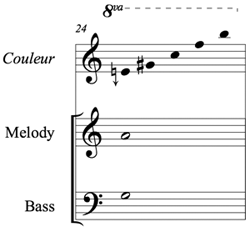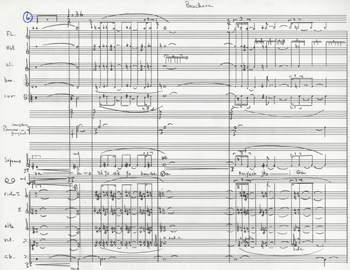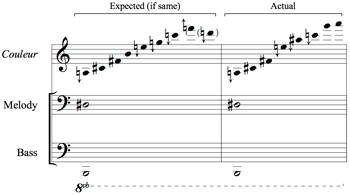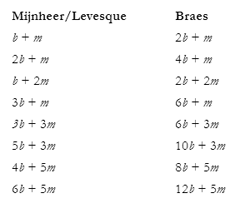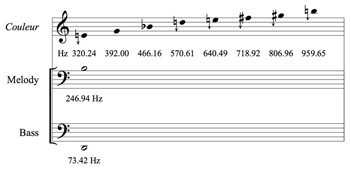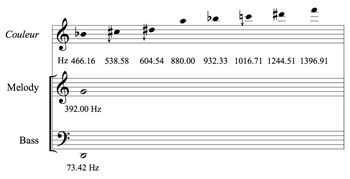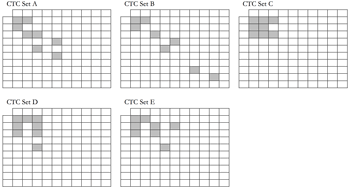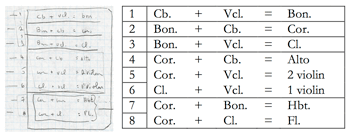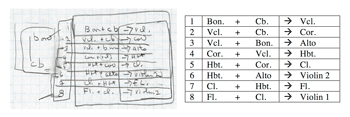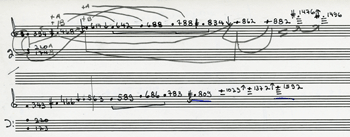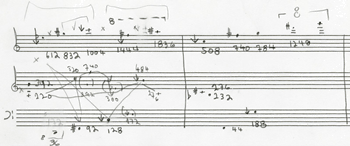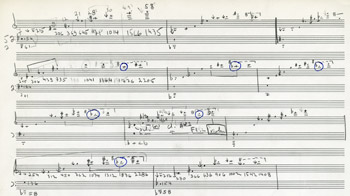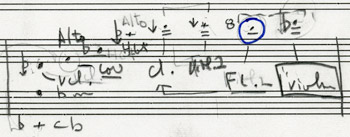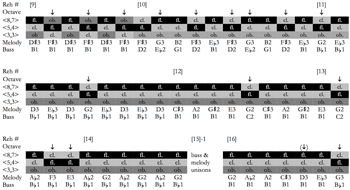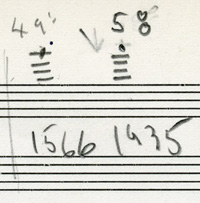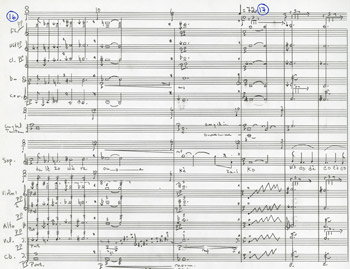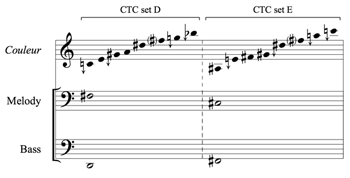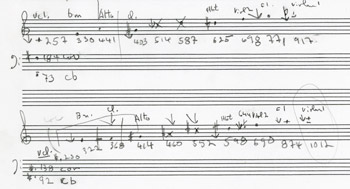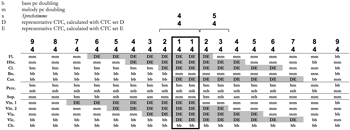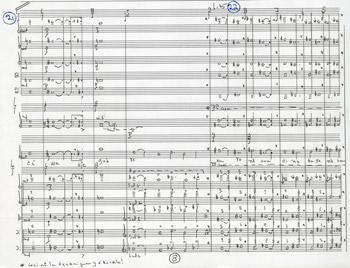Combination-Tone Class Sets and Redefining the Role of les Couleurs in Claude Vivier’s Bouchara *
Bryan Christian
KEYWORDS: Claude Vivier, Bouchara, Lonely Child, les couleurs, combination tones, ring modulation, frequency modulation, spectralism, post-spectralism
ABSTRACT: Claude Vivier’s homophonic treatment of combination tones—what he called les couleurs—demands an extension of traditional methods of harmonic and spectral analysis. Incomplete explanations of this technique throughout the secondary literature further demand a revised and cohesive definition. To analyze all variations of les couleurs, I developed the analytical concept of combination-tone classes (CTCs) and built upon Angela Lohri’s (2010) combination tone matrix to create a dynamic CTC matrix, from which CTC sets may be extracted. Intensive CTC set analysis reveals a definitive correlation between CTC set and formal sections in Vivier’s composition Bouchara. Although formally adjacent CTC sets are often markedly varied, all sets share a subset of lower-order CTCs, aiding in perception of spectral cohesion across formal boundaries. This analysis illuminates the interrelationships of CTC sets to their parent dyads, their orchestration, their playing technique, and form in Bouchara. CTC set analysis is compared with Vivier’s sketches for Bouchara, which suggest that les couleurs were intended as integral components of the work’s musical structure.
Copyright © 2014 Society for Music Theory
[1.1] Claude Vivier’s late style emerged in 1980 when he introduced a technique he called les couleurs in his work for soprano and orchestra, Lonely Child. This technique remained present, in one form or another, in almost all of Vivier’s works that followed. In his program note for Lonely Child, Vivier described the effect of this technique: “there are no more chords as such, and the whole orchestral mass is, in this way, transformed into timbre” (Reicher 1990).(1) Vivier had created a new way to highlight a single melodic line with his les couleurs, building on the work of spectral composers Tristan Murail and Gérard Grisey, with whom Vivier had become closely acquainted during a trip to Paris in 1979. This article will address a number of issues revolving around Vivier’s technique of les couleurs. First, I will give a general and historicized introduction to les couleurs. I will then address prior scholarly work on les couleurs and describe why the state of the literature demands a redefinition and further work; important and nuanced terminology will also be introduced and discussed here. To aid in my redefinition, I define a new analytical tool—combination-tone class set analysis—with which I carefully examine Vivier’s deployment of les couleurs and extract Vivier’s idiosyncratic approach to his own technique, which he even frequently undermined.
Origins of les couleurs
[1.2] Ross Braes (2003) has extensively shown the roots of Vivier’s couleurs in Vivier’s jeu de timbres—a term Vivier sometimes freely exchanged with Klangfarbenmelodie—in Vivier’s Orion (1979), Zipangu (1980), and Cinq chansons pour percussion (1980). Braes (2003, 13–14) advocates that “Vivier was apparently thinking of a vertical expansion of melody into something quasi-timbral.” As this marks a significant departure from the early twentieth-century classical understanding of Klangfarbenmelodie, Braes exclusively uses the term jeu de timbres throughout his dissertation to avoid a misunderstanding. Braes (2003, 14) defines jeu de timbres thus: “unlike harmonization of melodies in a tonal sense, the jeu de timbres comprises a series of complex vertical sonorities, based on the essential pitches of the principle melody, devised before actually writing the work.” Braes describes three typologies of jeu de timbres, saying the technique may “involve one or more of the following: interval-classes, overtone partials, and mirror inversions” (2003, 14). All three types of jeu de timbres are concerned with relationships to a provided input. For example, interval classes are only useful if an initial pitch is provided, at which point the prescribed relationship determines other specifics. The same is true with overtone partials and mirror inversions. This way of thinking is precisely in line with Vivier’s later implementation of and rationale behind using les couleurs. Speaking in an interview with Susan Frykberg (1982, 9), Vivier says “somehow, I discovered that the notes are not very important themselves, only their relationships. So it’s much more important to establish their relationships first. Also, what happens in this kind of situation, is that you always have some spontaneous beauty.”
[1.3] Vivier gave only rather vague descriptions of les couleurs in interviews, making statements such as “the music I'm writing now gives me total control because I have only one melody that I control continuously, with a whole system of colours, of added frequencies—it’s too complicated to explain—so that the music remains consistent all the time” (Reicher 1990, 37). In a separate statement (Reicher 1990, 32), Vivier confesses his preference towards understanding his work through listening to his music: “What I have to say, I must say with music. I can’t say it with words. That’s the problem. I can talk around the music, but it’s more difficult to talk about music as such, the music itself.” While Vivier’s statements add an alluring veil of mystery to his music, they are not particularly useful in defining les couleurs. At best Vivier’s “talking around” les couleurs in the former quote presents only the most basic information necessary to understand the technique.
[1.4] Vivier’s point of departure for les couleurs is the dyad. He says: “even two sounds superimposed . . . that's terribly complex. It's full of things, relationships, resolutions, superimposed spectra, etc. It's astonishing!” (Reicher 1990, 32). Indeed, les couleurs—which are, in a sense, varieties of stretched harmonic spectra—are reliant upon the frequency relationships of the two dyad pitches. The lower pitch of the dyad (bass tone) is often a drone, such as in Bouchara, or at least has a slower rate of change than the upper pitch (melody tone), thus presenting oblique motion. The couleurs themselves are essentially microtonal chords (quantized to a quarter-tone grid) where the pitch content is derived from the frequencies of the initial melody and bass tones. These couleurs typically move in homophony with the bass and melody dyad; a change in either dyad pitch results in a change in the pitch and interval content of the resultant couleur (even if produced with the same equations). Different types of dyad intervals also produce different realizations of couleurs; Vivier says, “depending on the tension of the interval, you get different couleurs” (Frykberg 1982, 9). The principle of combination tones—some of which are also called sum tones, in which the frequencies of the dyad pitches (and their integer multiples) are added to create more frequencies—is the foundation of the technique of les couleurs, which first appeared in Vivier’s masterpiece Lonely Child.
The First Couleur and Associated Techniques
Example 1. Les couleurs in Lonely Child, measure 24 (couleurs in Violin I, 1–5)
(click to enlarge and listen)
[2.1] Bob Gilmore’s article “On Claude Vivier’s ‘Lonely Child’” (2007) provides an excellent discussion of the various ways in which Vivier articulates the melodies in Lonely Child with les couleurs and how Vivier’s treatment of the technique changes throughout the work. Gilmore repeats some of this text in his discussion of Lonely Child in his more recent biography of Vivier (2014). In both publications, he provides a definition of the very first of les couleurs—reproduced from the score in Example 1(2)—to appear in Vivier’s oeuvre:
The A of the soprano, 440Hz, and the G of the second horn and cellos, 196 Hz, when “ring-modulated”, produce the combination tone of 636 Hz (a+b). . . . Then the process continues: the new pitch . . . is itself ring-modulated against the original G: 636 Hz plus 196 Hz gives the combination tone of 832 Hz (a+2b). . . . This new note is in turn ring-modulated against the G: 832 Hz plus 196 Hz gives 1028 Hz (a+3b). . . . And so the process continues, with two more, still higher, combination tones. (Gilmore 2007, 8; 2014, 166–67)
Comparing Gilmore’s quote with the couleur in measure 24 of Example 1, his definition is indeed correct and accurate as far as he takes it in his article and book. However, Gilmore does not complete a full analysis of the couleur. His statement, “and so the process continues” implies that the two higher tones would logically be defined following the pattern that has already been established. For example, if the first three tones are defined as (a+b), (a+2b), and (a+3b), and the “process continues,” then it would be logical to deduce from the information provided that the next two tones could be generated from (a+4b) and (a+5b). However, these equations return frequencies of 1224 Hz (Eb -29 cents and 1420 Hz (F +28 cents) respectively, neither of which resemble the two higher pitches of the couleur in measure 24. Even if the F +28 cents is rounded down to F instead of to the nearer F +50 cents, the F would have been produced with (a+5b), which is supposedly assigned to the fifth and highest pitch, not the fourth. Further, the
[2.2] In a lecture from 1992, several years before Gilmore’s article, Peter Tannenbaum also noted discrepancies in Vivier’s couleur in measure 24 and the equations he was able to deduce from Vivier’s sketches: (a+b), (a+2b), (2a+b), (2a+3b), and (3a+3b).(3) Tannenbaum’s equation for the third tone (2a+b) is quite different from Gilmore’s (a+3b) and although Tannenbaum claims to have verified his equation via sketches, Gilmore’s equation provides a more accurate description of what occurs in the score. Further, the confirmed equations presented by Tannenbaum are still relatively poor approximations of the top two pitches notated in the score:
[2.3] Gilmore likens the electroacoustic technique of ring modulation to Vivier’s les couleurs (recall the quote in which Gilmore even uses “ring-modulated” as a verb to describe Vivier’s treatment of frequency). Ring modulation is a classic analog effect from electronic music studios and became increasingly popular following Karlheinz Stockhausen’s iconic use of the technology in Mixtur (1964) and Mantra (1969–1970). Joshua Fineberg provides a clear and concise definition:
[ring modulation] is not hierarchic: there is not a carrier and a modulator which modifies it, but two equal sounds both of which are directly present in the resultant sound and both of which are modulated by the other. The spectrum resulting from a ring modulation can be [algebraically] simulated when the frequency of each note of the first spectrum is combined through both addition and subtraction with the frequency of each note of the second spectrum, producing all the possible additive and subtractive combinations of the partials. (Fineberg 2000, 97)
Although the ring modulation analogy is certainly appropriate, Gilmore presents equations that more closely resemble frequency modulation—(a+b), (a+2b), and (a+3b)—because there is no higher-order mixture of terms (i.e., only one variable, here b, takes a coefficient). The ring modulation metaphor requires a mixture of the spectrums of both signals, here a and b. Had Gilmore explained the two additional pitches, not with the implied (a+4b) and (a+5b) but with the (2a+3b) and (3a+3b) as provided by Tannenbaum, the appropriateness of his ring modulation analogy would have been clearer. Thus, the five equations of the couleur in measure 24 in Lonely Child are a subset of an algebraic representation of the ring modulation technique, assuming the signal inputs are sawtooth waves (a wave with all even and odd harmonics of the fundamental frequency). The two original input sounds in ring modulation are not typically present in the output, yet Vivier includes the original dyad with the algorithmically generated tones in les couleurs.
[2.4] Opposite Gilmore, Tannenbaum identifies equations that correspond to ring modulation, as just defined, yet he refers to the technique as frequency modulation (Braes 2003, 211).(4) Frequency modulation is not ring modulation and the terms cannot be used interchangeably, even as metaphor. Despite some conceptual overlap, this distinction is not semantic tiptoeing.
[2.5] Frequency modulation emerged with the beginning of radio in the early twentieth century, but it was not until 1973 that John Chowning first proposed using the frequency modulation technique with frequencies in the audible spectrum. Specifically, Chowning’s aim was to create a more computationally efficient method of producing complex timbres by varying a simple waveform by only a single modulating frequency rather than using the additive synthesis model with a large bank of oscillators. Presenting examples but not formalizing a general equation, Tristan Murail (1981)(5) gave an account of how frequency modulation may be carried out, not with audio signals as with Chowning’s approach but algebraically, in his 1980 Darmstadt lecture “La Révolution des Sons Complexes.” Two years later in a subsequent lecture at Darmstadt in 1982—“Spectres et lutins” (1983)(6)—Murail formalized a more general equation for frequency modulation, where m is the modulator, c the carrier, and i the index: freq = c ± mi.(7)
[2.6] Unlike Chowning’s departure from additive synthesis, Murail’s algebraic approach to frequency modulation produced a collection of frequencies that Murail would then orchestrate as a sort of instrumental additive synthesis. Bessel functions are commonly used to control the amplitude of the partials belonging to frequency modulation spectra, as first proposed by Chowning, although these are too precise to be used effectively for orchestration of an acoustic model.(8) For his orchestration of frequency modulation in Gondwana (1980), Murail (2005a, 131) says “the intensities of each component lessen as they ascend in pitch, while their durations are based on each component’s numerical position in the order.”(9) Although Viviana Moscovich (1997, 23) argues, “the whole harmonic generating principle in Gondwana is based on a technique of sound synthesis started by John Chowning,” Murail does not mention Chowning in either his talk from 1980 or 1982. In any case, this equation has a precedent in a nearly identical form, which in fact predates both Murail and Chowning by almost a century; in the early 1880s R.H.M. Bosanquet (1881–82, 21–23) proposed the expression n : in ± m to describe beats between mistuned consonances, where n is the frequency of the lowest tone, m the number of beats per second, and i a whole number which describes the interval in question (e.g., i=2 would describe the octave, i=3 the twelfth, etc.). As frequency modulation can create a sense of nuanced beating among partials, Bosanquet’s equation may be read as an early forerunner to frequency modulation.
[2.7] Vivier’s technique of les couleurs, as likened to ring modulation by Gilmore, may be misconstrued as frequency modulation if the higher-order terms are not taken into consideration, as in his incomplete example. On the other hand, Tannenbaum describes Vivier’s equations with higher order terms and thus it does not fit the frequency modulation equations outlined above. Ring modulation produces “all the possible additive and subtractive combinations of the partials” (Fineberg 2000, 97) and Vivier uses a considerably smaller number of frequency combinations—five in Example 1 from Lonely Child and eight in Bouchara discussed in the next sections. Thus, a more appropriate term for his technique is combination tones. François Rose (1996, 20) states that combination tones are “the acoustical counterpart to ring modulation.” In the fifth section of this article dealing specifically with my new analytical technique of combination-tone class sets, we will return to the concept of combination tones, briefly discussing their history and giving an analytical model by which we may approach Vivier’s les couleurs. As our case study we will turn now to Bouchara (1981), which presents both a more clear and a more extensive deployment of his signature technique of les couleurs.
Bouchara
[3.1] In Bouchara, for medium-size chamber ensemble and solo soprano,(10) Vivier removes all musical devices that he views as extraneous. In his interview with Frykberg (1982, 8), Vivier compares his first two works in which he uses les couleurs, saying Lonely Child is “pure melody, with colors on top of it, and the colors are contrapuntal. Whereas Boukhara [sic], which is the purest one I’ve done—twelve minutes of melody—there’s only the colors.” This purity of concept and execution makes Bouchara the ideal case study to uncover the nature of les couleurs. Additionally, Bouchara is Vivier’s only vocal work in which the sung text is presented exclusively in Vivier’s invented language. Only three non-invented words are included: Bouchara, dino, and marco.(11)
Example 2. Beginning of Section 1 in Bouchara, Rehearsal 6 (Université de Montréal, Fonds Vivier, MS P0235/D4,0002. Used by permission.)
(click to enlarge and listen)
Example 3. Bass drones used in each section of Bouchara. Notes in parenthesis indicate the contrabass playing an octave below the frequency value used for calculation
(click to enlarge)
[3.2] Bouchara is presented in three main sections and is framed with a prologue and a coda. The prologue is the only section that does not feature couleurs or full tutti orchestration. The prologue also presents the bass and melody pitches of the three sections and coda of Bouchara in a microcosmic rendition.(12) Vivier also numbers the page “zero” and labels it “Prologue”—“Bouchara” as labeled does not begin until page one at rehearsal 6, as seen in Example 2. As the prologue is a reduction of the remainder of the work, I will refer to Section 1 as beginning at rehearsal 6, Section 2 as beginning at rehearsal 9, Section 3 as beginning at rehearsal 17, and the coda as beginning at rehearsal 22.
[3.3] The three sections and coda of Bouchara are characterized by a collection of drones in the bass, as seen in Example 3. The frequencies of these bass drones are used as the “bass” in the calculations for each section’s respective couleur. The two exceptions are in Sections 1 and 3 where the contrabass plays an octave lower than the frequencies used for the calculations, shown by the notes in parentheses in Example 3. In each section the vocal line is doubled by a different instrument at the octave or at two octaves: by the horn in Section 1, the bassoon in Section 2, and the cello in Section 3. The coda, again, is a special case to be discussed later. The frequencies of the pitches played by the doubling instrument are used as the “melody” in the calculations for each section’s couleur. Therefore, the pitches of the contrabass and the doubling instrument make up the bass and melody dyad respectively. Unlike Lonely Child, in Bouchara it is in fact the frequency on the doubling instrument that is used in the calculations of les couleurs, not the frequency of the soprano’s pitch. Since the pitch is doubled at the octave or at two octaves, this distinction is especially important.
[3.4] As seen in Example 2, the voices assigned to the couleur in this section (all but the horn, voice, contrabass, and percussion) move in parallel motion with the voice and horn. This is an artifact of the oblique motion between the melody and bass: because Vivier added their respective frequencies in multiple configurations, when one voice remains constant and the other moves, the realization of the couleurs also moves in parallel motion. This parallel motion, however, is not chromatically parallel harmony, or planing, as commonly found in the music of Claude Debussy and Maurice Ravel. The intervals between the pitches of Vivier’s couleurs also move in parallel motion, yet expand and contract given the distance of the melody tone from the bass tone. For example, the bass tones in Bouchara are drones and are thus fixed. The further the melody tone above the bass tone, the more condensed the intervallic structure of the couleurs, even though the couleur for each bass/melody pair is constructed with the same set of equations. This effect is due to the log scale of pitch and because Vivier’s additions were made in frequency space, not in linear pitch space. Nonetheless, all voices move in parallel motion. I label this effect “frequency planing.”
[3.5] There are only a few exceptions to frequency planing in Bouchara, all of which occur in Section 2, in the four measures between rehearsal 10 and rehearsal 11. When the melody/bass frequency ratio between two dyads is the same and realized with the same equation, the couleurs will be identical under the same interval of transposition. In other words, when both the melody and bass plane chromatically, so does the entire realization of the resulting couleur. This is an exception because Vivier generally uses drones for the bass tone, resulting in frequency planing, yet the couleurs at rehearsal 10 chromatically plane because the bass moves in chromatic parallel motion with the melody.
Couleurs in Bouchara
[4.1] Patrick Levesque, Jaco Mijhneer, and Ross Braes have all published on les couleurs in Bouchara; so why is it necessary for me to cover this material again? First, I will show that there are inconsistencies in the authors’ equations and conclusions and, second, that their work may be built upon to show that les couleurs do not only have a coloristic or ornamental role, but also a structurally significant role: their constructions reinforce the large scale form in Bouchara.
[4.2] In his thesis (2004), Patrick Levesque provided an analysis of les couleurs in Bouchara, analyzing what I label Section 1; in a subsequent article (2008) he analyzed two couleurs from this same section. In both analyses (2004, 41; 2008, 94), Levesque provides the definition of the couleurs for the first section of Bouchara as follows:
| f1 +f2 = f3 | (b+m) | f1 + f3 = f4 | (2b+m) |
| f2 + f3 = f5 | (b+2m) | f3+ f4 = f6 | (3b+2m) |
| f 4 + f5 = f7 | (3b+3m) | f4+ f6 = f8 | (5b+3m) |
| f 5 + f7 = f9 | (4b+5m) | f7+ f8 = f10 | (8b+6m) |
Closely examining Levesque’s results shows that his equations for Section 1 of Bouchara are nearly all correct. However, the equation for the highest pitch (8b + 6m) does not yield the correct, or even nearby, frequencies when the appropriate bass and melody frequencies are provided. In both publications Levesque presents a chart in which he lists the resultant frequencies of his calculations, which are correct for the highest pitch, presenting a discrepancy between his equation and his results. The correct frequencies for the highest pitch of this couleur may be given by the equation (6b + 5m).
Example 4. Expected and actual couleur realizations at the beginning of Section 2 in Bouchara
(click to enlarge and listen)
[4.3] Although Levesque limits his analysis to rehearsals 6–9, he does not explicitly state that his equations do not define the couleurs in subsequent sections in Bouchara. Example 4 shows the difference between what would have been the first couleur in Section 2, had we continued to use Levesque’s equations from rehearsals 6–9 for its realization, versus the actual couleur that appears in the score. The audio that accompanies this example reflects this new couleur. The top pitch of the “expected” realization is calculated with Levesque’s incorrect equation; the correct pitch is provided immediately following in parentheses.
[4.4] Even with the corrected equation for the top pitch, three of the pitches in the expected and actual couleur realizations from Example 4 are different, showing that the definition provided by Levesque for rehearsals 6–9 no longer applies at rehearsal 9. Here, the algorithm has shifted, and, in the context of Bouchara, this marks the beginning of a new section, also signaled by the bass drone descending from C down to B and the instrument that is doubling the voice switching from horn to bassoon. This shift in couleur construction at rehearsal 9, shown by the incompatibility of the algorithm from the preceding measures with the resultant sonority, illustrates that there are multiple couleur constructions at play in Bouchara, to which we will return later in this article.
[4.5] Jaco Mijnheer (1998) has also produced algorithms for Section 1 of Bouchara, and has been the only scholar to mention different equations for Section 2. These equations, however, are mentioned somewhat in passing and the differences and similarities between the equations for each section demand analytical attention. Over a decade later, Braes (2003, 209) “corrected” some of Mijnheer’s algorithms in his thesis and also provided frequency values, listing the equations for Section 1 of Bouchara as follows:
| A = 65 Hz (bass tone) | B = 154 Hz (melody tone) |
| C = 2A + B (284 Hz) | D = 2A + C (414 Hz) |
| E = B + C (438 Hz) | F = C + D (698 Hz) |
| G = D + E (825 Hz) | H = D + F (1112 Hz) |
| I = E + G (1290 Hz) | J = F + G (1550 Hz) |
Example 5. Vivier’s calculation of the first couleur in Section 1 on 130 Hz and 154 Hz (Université de Montréal, Fonds Vivier, MS P0235/D4,0002. Used by permission.)
(click to enlarge)
[4.6] Although Braes’s equations yield accurate end results corresponding to the exact frequency values provided by Vivier, it is odd that Braes should describe the equations as corrections. In fact, Braes obfuscates the underlying construction of the couleur by writing the first term as 2A in equations C and D, and equations E through J by extension. As shown in Example 3, in this section of Bouchara the contrabass plays a note an octave below the note whose frequency is used for the calculation of les couleurs. Braes was surely aware that a C 130 Hz was used, not the lower octave C 65 Hz, as he included examples of Vivier’s sketches containing these numbers on the very same page as his discussion of the algorithm. Example 5 shows the corresponding calculations from Vivier’s sketches.
Example 6. Mijnheer, Levesque, and Braes’s equations for les couleurs at Rehearsal 6 in Bouchara
(click to enlarge)
[4.7] The different portions of the sketch in pencil and blue pen suggest that Vivier first calculated the frequencies for the couleur and only later assigned their orchestration. Additionally, this sketch shows that Vivier’s decision to transpose the contrabass an octave lower than the frequency used to generate the couleur was an additional step in the process. Thus, Braes’s use of 65 Hz misrepresents the true nature of the couleur’s construction. This distinction might seem relatively minor since Braes arrives at the same frequencies as seen in Vivier’s sketches and is ultimately in agreement with Mijnheer. Yet the necessity of always multiplying the 65 Hz value by two has consequences when formally comparing this particular couleur with other couleurs, as we will see in subsequent sections of this article. For example, Braes’s equations may be rewritten to compare with those of Mijnheer or Levesque using simple mathematical substitution and combining of like terms, thus presenting each tone in terms of the melody and bass frequencies, as in Example 6. For consistency and ease of comparison, Braes’s bass and melody is rewritten A = b and B = m.
[4.8] In Example 6 the equations are identical except that the coefficients for the bass term in Braes’s equations are always twice that of the corresponding coefficients in Mijnheer and Levesque’s equations. Although this doubling ensures that the frequency of the contrabass low C is brought into the correct octave, it clouds the relationships between the various equations because the melody term’s coefficient is not also multiplied by two, and thus is not factored out. Thus the symmetry of the first three equations of Mijnheer and Levesque (b+m, 2b+m, and b+2m) is lost in the corresponding equations of Braes’s realization (b+m, 4b+m, and 2b+2m). Further, comparing different sections and couleur constructions of Bouchara using Braes’s equations would potentially skew what would otherwise be clear patterns and regularities.
[4.9] Given the inconsistencies of terminology and the variance in the algorithms presented by Gilmore, Tannenbaum, Levesque, Mijnheer, and Braes in their discussion of les couleurs, I developed the analytic concept of combination-tone class sets by which we may consistently and objectively evaluate les couleuers.
Combination-Tone Class Sets
[5.1] Vivier’s couleurs are constructed from low- and high-order combination tones of the bass (b) and melody (m) frequencies in the form of
αb + βm
where α and β are nonnegative integers and b and m are frequencies in Hz.(13) My equation is modeled after Carl Stumpf’s (1910) definition (±αh ± βt) of combination tones from 1910,(14) differing in that the form presented here includes only the sum tones, consistent with Vivier’s practice. Unlike Hermann von Helmholtz(15) (and other predecessors in combination tone and acoustic theory(16)), whose definitions relied more on representing the harmonic ratios (e.g., frequencies with the harmonic interval of 3/2 would have a sum tone of 3+2=5), Stumpf’s definition gives low- and high-order combination tones for any combination of frequencies, including those which may not reduce to a low-integer ratio.
[5.2] Gilmore’s examples from Lonely Child are more akin to frequency modulation because either α or β is always assigned the number one, which suggests carriers and modulators. With combination tones, on the other hand, either and/or both α or β may be assigned integers greater than one.(17) Aided by Stumpf’s model of combination tones, I created combination-tone class set analysis, with which I will define all variations of les couleurs present in all sections of Bouchara. Comparing my results with Vivier’s calculations in his sketches validates the accuracy of this technique, despite Vivier’s tendency to occasionally round pitches opposite the expected direction (i.e., the second nearest quarter tone rather than the nearest quarter tone) in a seemingly spontaneous manner.
Example 7. CTC matrix cell indices corresponding to CTCs
(click to enlarge)
[5.3] A combination-tone class (CTC) is a shorthand reduction of the equation proposed above and written <α , β >. For example, the CTC for the first combination tone (1b+1m) is written <1,1> and the higher-order combination tone (3b+5m) is written <3,5>. Each couleur is thus made up of a collection of CTCs and may be defined as a CTC set. Unlike pitch class sets and beat-class sets, CTC sets do not use the modulo operation, largely due to the fact that CTCs represent relationships rather than fixed states. However, there are other types of symmetry and repetition which may occur with combination tones, as shown by Angela Lohri (2010) in her combination tone matrix. For instance, the points of symmetry of Lohri’s combination tone matrix change in relation to the harmonic ratio of the two primary tones. Lohri follows the Helmholtz model of representing combination tones as harmonic ratios. Taking Lohri’s combination tone matrix as a model and integrating it with my neo-Stumpfian approach, I define a CTC matrix as a matrix in which the indices of each cell correspond to α and β of a CTC, all of which are realized with a given b and m value. The matrix may be extended to infinity in both dimensions, yet it appears an 11x11 matrix will usually contain the CTCs needed for analysis of Vivier’s music (of course, it can always be extended or compressed as needed). Although not a working CTC matrix, Example 7 shows the correlation between cell index and CTC. Regardless of the b and m values selected to realize the CTC matrix, this underlying framework is consistent to all CTC matrices.
[5.4] For each new b and m combination, a new CTC matrix is generated by converting the CTCs in each cell back to the form αb + βm and calculating the corresponding combination tone (in Hz). Each unique CTC matrix is labeled CTCM(b,m). This generates a matrix of all possible combination tones for the provided b and m frequencies, which may then be used as a reference table to determine if a consistent set of cells—and thereby CTCs—is used to construct various couleurs in the same section. If the couleurs of different b and m combinations contain frequencies in the same cells in their respective CTC matrices, then the couleurs share the same equations. A selection or group of cells (corresponding to CTCs) from a CTC matrix is called a CTC set and is notated A = (<1,1>, <1,2>, <2,1>, . . .).
Example 8. Couleur for D2 and B3 in Section 3 of Bouchara
(click to enlarge and listen)
Example 9. CTCM(73,246) with highlighted cells referring to the target couleur
(click to enlarge and listen)
[5.5] Example 8 shows a couleur from Section 3 of Bouchara produced with a b and m dyad of 73.42 Hz (D2; presented an octave higher than sounding in the contrabass—see Example 3) and 246.94 Hz (B3; the cello doubling the voice an octave lower), including the frequency of each combination tone. These pitches were extracted from the manuscript score and their frequencies extrapolated from an equal-tempered quarter-tone grid with a tuning reference of A 440 Hz. These frequencies will be our target frequencies when analyzing this particular couleur. A 440 Hz is an appropriate tuning reference, as opposed to A 442 Hz for example, because Vivier routinely used A 440, and its octave equivalents, for all bass and melody As. In his sketches, Vivier used nonnegative integers for the initial bass-melody frequencies to simplify the many calculations he completed by hand. However, Vivier did not always round his equal-tempered pitches to the nearest integer frequency. For instance, in the calculations from his sketches for the couleur reproduced in Example 8, Vivier used 246 Hz for B3 (246.94 Hz) instead of 247 Hz. Such minute differences are negligible because Vivier quantized his combination tones to a quarter-tone grid and even frequently rounded to the second nearest quarter tone. Thus, the target frequencies extracted from the score are already approximations of the idealized combination tones.
[5.6] Following Vivier, we will use the bass-melody integer frequencies from his sketches—73 Hz and 246 Hz for the couleur from Example 8—when calculating the CTC matrices. Example 9 shows CTCM(73,246) and highlights the cells (CTCs) with the eight frequencies that most closely correspond to the couleur from Example 8. Extracting the highlighted cells’ corresponding CTCs into a collective group defines the couleur’s CTC set. Approximate target frequency matches are occasionally necessary because of Vivier’s bass-melody frequency rounding and combination tone frequency quantizing. Nonetheless, the validity of the CTC approach is given by the overall consistency of the CTC set across multiple target couleurs, which shows the couleurs from the sample were all calculated with the same set of equations.
[5.7] The nomenclature for labeling CTC sets is determined on a case-by-case basis and should be consistent within each analysis. Because Examples 8 and 9 show the couleur that happens to define the third section of Bouchara, we will label ours “C” and write it as:
C = (<1,1>, <2,1>, <3,1>, <1,2>, <2,2>, <3,2>, <1,3>, <3,3>)
Example 10. Couleur for D2 and G4 in Section 3 of Bouchara
(click to enlarge and listen)
Example 11. CTCM(73,392) with highlighted cells referring to the target couleur
(click to enlarge and listen)
[5.8] We can confirm that CTC set C algorithmically defines the couleur for Section 3 by carefully comparing different CTC matrices within the section to determinine if the same cells remain highlighted for the frequencies nearest the target couleurs.(18) Nuanced cross-comparison is especially important because Vvier rounded and quantized by “feel”: he would make these rounding exceptions if doing so would give a slightly more even distribution of equal-tempered and microtonal pitches per sonority. Thus, if a given frequency value is within a quarter-tone of the target, even if not the nearest, it may be considered as an acceptable candidate under the right circumstances. Still, however, the resultant frequencies of that cell must also correspond to the correct pitches through the entire section. As a demonstration, Examples 10 and 11 show that the couleur extracted from the score for D2 and G4 in Section 3 has the same CTC set as the couleur generated by D2 and B3 in the same section; the nearest frequencies to the target couleur are all found in the same cells of each respective CTC matrix.
[5.9] To match the target couleur in Example 10, one frequency value from CTCM(73,392) must be rounded to a value other than the nearest quarter-tone: 857 Hz (A -46 cents) is quantized to A instead of A -50 cents. This is not so much a mistake as it is a conscious balancing decision made by Vivier.
[5.10] The interval structure of the couleur presented on D2 and B3 is substantially different from the interval structure of exact same couleur realized with D2 and G4 (compare Examples 8 and 10), thus presenting the perfect example of frequency planing. Despite this substantial intervallic difference in pitch space, both couleurs share the same CTC set. Examining a larger sample size reveals that all couleurs within Section 3 may be defined by CTC set C as listed above.
[5.11] From these examples a few general observations may be made about CTC matrices and CTC sets. First, the upper left hand corner, <0,0>, is null and therefore omitted. The 0th column and 0th row represent the natural overtone series of b (i.e., αb + 0m) and m (i.e., 0b + βm) respectively. Moreover, column 1 and row 1 correspond to positive sideband frequency modulation between b and m; column 1 treats m as the carrier and b as the modulator (αb + 1m), where row 1 treats b as the carrier and m as the modulator (1b + βm).(19) All the cells, except for values in the 0th row and column correspond to combination tones, including the overlapping tones that coincide with frequency modulation. Thus, in a single tool CTC matrices may be used to simultaneously compare the three most prominent techniques used in early spectralism and post-spectralism: the natural overtone series, frequency modulation, and combination tones. Therefore, CTC set analysis may be adapted to study many other spectral works beyond those found in Vivier’s oeuvre.(20)
The Five CTC Sets of Bouchara
[6.1] CTC sets define les couleurs in mathematical terms of the bass and melody frequencies of the generating dyad. However, Vivier did not define his couleurs in this manner. Rather, Vivier used a more chain-like method, calculating each additional combination tone from preceding combination tones or the initial bass and melody tones. This is also the approach taken in most of the secondary literature, with the exception of Levesque. However, algorithms with no or few like terms are exceptionally difficult to directly compare. This is especially true for the upper-most combination tones of the algorithms, which in Vivier’s notation are defined by combinations three or more levels deep. The issue is further complicated when different instruments are assigned to the melodic voice for each section, thus changing the initial terms. CTC sets, however, express the algorithms in like terms and offer the facility to compare different sets of various sizes if needed.
[6.2] CTC set analysis reveals five CTC sets at work in Bouchara, with one CTC set for each of the first three sections (labeled A, B, and C) and two alternating CTC sets in the coda (D and E). Section 2 contains many unique compositional exceptions to the more straightforward presentations and frequency planing generally found throughout Sections 1 and 3. Both Section 2 and the coda’s unique alternating CTC sets will be discussed in detail later in this article. The five CTC sets are defined as follows:
| A = (<1,1>, <2,1>, <1,2>, <3,2>, <3,3>, <5,3>, <4,5>, <6,5>) |
| B = (<1,1>, <2,1>, <1,2>, <3,3>, <5,4>, <4,5>, <8,7>, <9,9>) |
| C = (<1,1>, <2,1>, <3,1>, <1,2>, <2,2>, <3,2>, <1,3>, <3,3>) |
| D = (<1,1>, <2,1>, <3,1> <1,2>, <1,3>, <2,3>, <3,3>, <5,3>) |
| E = (<1,1>, <2,1>, <3,1>, <1,2>, <2,3>, <3,3>, <5,4>, <2,5>) |
Example 12. The five CTC Sets of Bouchara displayed on empty CTC Matrices
(click to enlarge)
[6.3] CTC sets A through E are presented in Example 12 as highlighted cells of empty CTC matrices; although empty, the cell indices still correspond to their respective CTC. Placing these matrices side by side provides a clear visualization of the degree of difference between the CTC sets.
[6.4] Comparing these matrices reveals a number of otherwise hidden properties. All five CTC sets have a common subset of four CTCs: (<1,1>, <2,1>, <1,2>, <3,3>). Thus, half of the CTCs in all the couleurs in Bouchara are produced by the same exact pitch relationships to their corresponding bass and melody pitches. Further, this subset contains the three lowest-order CTCs, concentrating the variation in the higher tones. This subset therefore projects a sense of harmonic and spectral consistency across formal boundaries because the harmonic relationships between the three lowest CTCs to their generative dyad are the most sonically discernible. Had we used Braes’s equations, placed in terms of the bass and melody frequencies, this subset relationship would have been unrecognizable, despite his equations producing the correct frequencies. This analytical clouding is not a failing on Braes’s part, as he did not use CTC sets, but it acts as an excellent example as to why it is essential that all terms must be reduced as much as possible in order for their relationships to be best represented by CTC set analysis.
Example 13. Adjacent CTC Sets in Bouchara
(click to enlarge)
[6.5] Example 13 compares adjacent CTC sets A:B, B:C, and D:E. Black cells represent shared CTCs between the sets, light gray cells represent the initial CTC set’s unshared CTCs, and darker gray cells represent the arrival CTC set’s unshared CTCs. Arrows do not correspond to changes in orchestration, but rather illustrate translations and rotations in CTC space.
[6.6] The only significant textural break in Bouchara—a measure of homophonically articulated natural harmonics with a hummed soprano line and no winds—occurs immediately before the coda, the measure before rehearsal 22, thus separating Section 3 from the coda. Further, the four measures preceding this textural change consist of tutti doublings of the bass and melody tones in various octaves—not CTC set C—and, considering CTC sets D and E do not appear until the third measure of the coda, it is sufficient to say that CTC sets C and D are not adjacent. For these reasons C:D is not included in Example 13.
[6.7] CTC sets A and B have five common CTCs, whereas the remaining three translate in CTC space. Translation in CTC space may be defined as Tu,v = <α+u,β +v>. Thus, <5,3> and <6,5> both translate at T3,4 and <3,2> translates in the same direction at T2,2. Because the already widely spaced CTCs expand to the even higher-order tones, the couleurs of CTC set B have a more abstracted relationship to their bass and melody tones. This increase in harmonic and spectral tension in the upper three CTCs is further articulated by a number of subtle modifications to the orchestration in Section 2, discussed in the next section.
[6.8] The transition from Section 2 to 3 is the most sonically perceptible change in CTC set as the widely spaced CTCs of CTC set B contract to the tight-knit grouping of CTC set C. CTCs <5,4> and <4,5> translate at T-2,-3 to <3,1> and <2,2>. CTCs <8,7> and <9,9>, however, present a more complicated relationship: both CTCs rotate 90° counterclockwise around the origin to <-7,8> and <-9,9> and then translate at T10,-6 to <3,2> and <1,3>. This collapsing into lower-order CTCs greatly decreases the sense of harmonic and spectral tension characteristic of Section 2. Consequently, the harmonic relationships between the couleurs in Section 3 and their respective bass and melody tones are clearer, especially when their harmonic ratio may be represented by low integers, as we will see at rehearsal 17. Additionally, the clustering of CTCs for CTC set C suggests a narrower bandwidth than the more widely spaced CTC set B. This cluster collectively places the couleurs in Section 3 in a narrower and lower register, with respect to their generating dyads.
[6.9] In the coda, the difference of CTC sets D and E is the most subtle of the CTC set comparisons, largely due to their six common CTCs and because the translated CTCs move a comparatively small distance. However, rather than hearing the CTC set change only once at the section boundaries, as with the other relationships described, CTC sets D and E represent a special case and are continually alternated in the coda.
Example 14. Vivier’s definition (from his sketches) of the couleur for Section 3 in Bouchara (Université de Montréal, Fonds Vivier, MS P0235/D4,0002. Used by permission.)
(click to enlarge)
Example 15. Vivier’s incorrect or unused definition (from his sketches) of the couleur for Section 2 in Bouchara (Université de Montréal, Fonds Vivier, MS P0235/D4,0002. Used by permission.)
(click to enlarge)
[6.10] Vivier did not often define the algorithms for les couleurs in his sketches. Bouchara is an anomaly: it is his only work with fully and clearly expressed algorithms for les couleurs. In an endnote following his discussion of les couleurs, Levesque (2004, 44; 2008, 95) gives the disclaimer that, following his calculation of Vivier’s equations for Section 1’s couleur, he later discovered many of the algorithms in Vivier’s sketches. This, however, is an oversimplification of the contents of Vivier’s sketches, which are not as straightforward as Levesque suggests. In fact, I have only identified two clearly stated algorithms in the sketches to Bouchara, despite the five algorithms that we might suspect. Of these two, only one algorithm is used to calculate the pitches for one of the sections in Bouchara. Example 14 shows and transcribes Vivier’s definition of the couleur assigned to Section 3. Substituting equations and combining like terms indeed yields the same result as CTC set C. Vivier’s algorithm for Section 2 (Example 15), however, does not correspond to CTC set B.
[6.11] Substituting and combining like terms in Example 15 in the same manner as before yields the following CTC set for Section 2, labeled BS, with the subscript “S” designating that it was derived from Vivier’s sketch. Apart from this chart, BS does not appear elsewhere in the sketches or final score to Bouchara. Because of this inconsistency, not only are these algorithms incomplete, but they are also unreliable as the key to les couleurs.
BS = (<1,1>, <2,1>, <1,2>, <3,2>, <5,3>, <4,4>, <8,5>, <13,8>)
BS ≠ B
Example 16a. Vivier’s couleur sketches for Lonely Child (Université de Montréal, Fonds Vivier, MS P0235/D4,0025. Used by permission.)
(click to enlarge)
Example 16b. Vivier’s couleur sketches for Samarkand (Université de Montréal, Fonds Vivier, MS P0235/D4,0054. Used by permission.)
(click to enlarge)
[6.12] CTC sets BS and B share only their lowest three CTCs. Otherwise, the only common trait between B, the algorithm that Vivier eventually settled on, and BS is that both are considerably more expansive than the other CTC sets used throughout Bouchara. Clearly, Vivier wanted a substantially different sound in Section 2. Several erased instrument assignments can be faintly seen behind the algorithm sketch in Example 15, suggesting that Vivier did not simply arbitrarily decide on an algorithm but rather worked through at least more than one possibility. Significantly, only two of the five CTC sets are defined in this manner, one of the two is not used, and similar charts do not appear in his sketches to other works. Perhaps Vivier used these charts not to define the couleurs, but as another representation of his algorithm. In sketches to other works that use les couleurs, Vivier’s process of working out the algorithm can almost be followed by tracing lines drawn between added pitches. Examples 16a and 16b show Vivier working out such algorithms in Lonely Child and Samarkand (1981) respectively, where in both cases the lines are drawn on the first couleur in their corresponding sections.
[6.13] As seen in the second couleur written out in Examples 16a and 16b, Vivier did not include the lines in subsequent calculations. It is possible, nevertheless, that the lines were an afterthought or a mnemonic aid for the process he had established. Example 16a presents a stronger case for this reading because the lines appear to have been added later in pencil to the already written pitches and frequencies in pen, perhaps representing a sort of analysis. In Example 16b, however, the lines seem to play a much more integral role in Vivier’s calculation of the material, where he can be seen working through his material. For example, the pitches in parentheses do not occur in the subsequent couleur. In any case, such lines do not appear in the sketches for Bouchara. A process of working through the material may be seen in Vivier’s calculation of the two couleurs in the coda; lines linking summed pitches or other connections are not included as they are in Lonely Child and Samarkand. Further, Examples 16a and 16b define les couleurs in terms of instrumental combinations, thus also providing the orchestration for each. As we will see in Section 2, Vivier’s orchestration of les couleurs appears to operate independently of their calculation, which supports the premise that these charts were indeed produced following, and in fact not as the definition of, the algorithm. Although I can only speculate as to the origin of the other four couleurs that are not defined outside of the consistency of their respective calculations, CTC set analysis shows a consistent approach to how Vivier constructed his couleurs in Bouchara: the CTC sets were designed to enhance the sense of tension and release between formal sections. Moreover, the variations found within les couleurs, even before orchestration or other modifications, support the plan and trajectory of large-scale form in Bouchara.
Modifications to les couleurs in Section 2 of Bouchara
[7.1] Section 2 in Bouchara is full of potential analytical pitfalls. Because Vivier makes modifications to les couleurs after calculating their respective frequencies, a cursory harmonic or spectral analysis, CTC set or otherwise, will likely fail or be misleading. Analyzing Section 2 without taking Vivier’s modifications into account potentially yields over ten possible CTC sets for this section alone. Given the consistency of one couleur per section in Sections 1 and 3 as we have observed, it seems unlikely that Section 2 would have this degree of variance in its couleurs. Indeed, Vivier could have wished to project a vastly different approach in Section 2, but the consistency of frequency planing suggests that the equations are likely stable throughout the section. Closer examination reveals that in all bass-melody dyad pairs in this section only one combination tone seems to freely move within the CTC matrix (thereby suggesting various CTCs for its value and implying multiple CTC sets in this section). The other seven CTCs remain fixed. Although Vivier could have left that one value “open,” the target frequency is always present in the CTC matrix, within an acceptable rounding resolution, an octave higher at <8,7>. This particular frequency is then, typically but not always, transposed down an octave.
[7.2] Inattentive CTC set analysis suggests many possible CTC sets for this section, as opposed to a single definitive CTC set, because the α and β values of <8,7> are not divisible by two and thus the pitch an octave below that of <8,7> is not consistently present in any of the CTCs with lower integers. Although an overlap could occur in special cases with some bass and melody dyads, the CTC representing this overlap would not be consistent. Had the CTC set been <8,8>, for example, the realized pitch of <4,4> would always be an octave lower for all bass and melody pairs. Therefore, Vivier’s octave transposition of <8,7> is a modification to the couleur, not entirely unlike Vivier’s octave transposition of the contrabass in Section 1.
Example 17. Vivier’s calculation of the couleur in Section 2 of Bouchara (Université de Montréal, Fonds Vivier, MS P0235/D4,0002. Used by permission.)
(click to enlarge)
[7.3] Following these conclusions and this analysis, I compared my results with Vivier’s sketches for Section 2, which confirmed my hypothesis. Example 17 shows a subset of Vivier’s calculations of les couleurs for Section 2.
Example 18. Definition of blue pen circle enclosure (Université de Montréal, Fonds Vivier, MS P0235/D4,0002. Used by permission.)
(click to enlarge)
[7.4] As seen in Example 17, all of the calculations for the pitches for les couleurs in Section 2 were written in pencil. Thus, it must have been in a different stage of the composition process, even if immediately following, that Vivier switched to blue pen to circle nearly every penultimate pitch of each couleur in this section. As seen in Vivier’s annotation at the bottom of the page of his sketch for Section 2’s couleurs (Example 18), a circle enclosure indicates that the enclosed note should be transposed down an octave. This is consistent with the observations made by CTC set analysis.
[7.5] Vivier did not circle the penultimate pitch for every couleur in this section. Rather, he only circled the penultimate pitches that were above
Example 19. Octave transposition orchestration assignment to the Cl./Hbt. in Section 2 of Bouchara (Université de Montréal, Fonds Vivier, MS P0235/D4,0002. Used by permission.)
(click to enlarge)
Example 20. Octave transposition orchestration assignment to the flute in Section 2 of Bouchara (Université de Montréal, Fonds Vivier, MS P0235/D4,0002. Used by permission.)
(click to enlarge)
Example 21. Flute, clarinet, and oboe orchestration in Section 2 of Bouchara
(click to enlarge and listen)
[7.6] Looking at the orchestration assignment more closely in Example 18, we can detect that a faintly erased marking lurks in the background. Vivier had initially assigned this octave transposition to the oboe as seen with the mostly erased “Hbt.” marking behind the “Cl.”—Example 19 enlarges this section and increases the contrast so this alteration is more easily visible. It appears that Vivier had initially preferred the oboe to the clarinet for this orchestration assignment. Just midway down the page in Example 17 (reproduced and enlarged in Example 20), however, Vivier also indicated that the transposed note should be assigned to the flute.
[7.7] Consequently, we are left wondering how this pitch is orchestrated—with the clarinet, oboe, or flute? Although these are the only hints provided in the sketches, the score reveals that all three instruments are used, each assigned to specific bass and melody pair, and thus couleur, combinations. The orchestration is locked as in Example 20 for all other instruments. For example, Violin I is always assigned to the top CTC <9,9>, and Violin II to the sixth CTC <4,5>. The clarinet, oboe, and flute, however, freely exchange positions with the fourth <3,3>, fifth <5,4>, and seventh <8,7> CTCs. There is no correlation between orchestration assignment and which couleurs have a transposed <8,7>: the threshold of
[7.8] Had Vivier assigned only one instrument to <8,7>, he would have created a single disjunct line due to the alternations of couleurs in which the pitch was and was not transposed. To avoid a single outlier amidst otherwise parallel motion, Vivier’s solution was to vary the orchestration between the three wind instruments that could easily play <8,7>, thus creating a sense of consistent variety in the winds. Although this quasi-rotational orchestration does not have an effect on the definition of the couleur, it greatly skews the perception of the parallel musical line in the upper woodwinds. The clarinet, oboe, and flute frequently change positions (while concurrently sometimes transposing their corresponding pitches down an octave) whereas the other five instruments frequency plane in parallel motion with the melody. This interweaves their lines and disrupts their respective sense of frequency planing. Example 21 shows the orchestration of all dyads in Section 2 in the order they appear in the score (successive repetitions removed). A downward arrow above a cell means the pitch of the instrument listed in the <8,7> row is transposed down an octave.(21)
[7.9] Examining Example 21, the oboe is in the highest position (of these three instruments) for one dyad—B1,
[7.10] These instrumental alternations, however, are artifacts of Vivier’s melodic line. Because the melody determines the couleur, so too does it determine the orchestration as Vivier only orchestrates each dyad in a single configuration. A further distinction is that the instrument assigned to <8,7> does not always have the highest pitch of the three instruments because of the independent process of octave transpositions described earlier.
[7.11] Quasi-rotational orchestration in this manner only occurs in Section 2. In Sections 1 and 3 and the coda, frequency planing is maintained and clearly projected in all eight instruments assigned to les couleurs. Despite the changing orchestration—with five of eight instruments frequency planing in Section 2, and chromatically planing between rehearsals 10 and 11—a sense of consistency between Sections 1 through 3 is still projected. Nonetheless, the intertwining upper woodwinds add a sense of internal variance to Section 2 and provide an excellent contrast to the more salient parallel motion in Sections 1 and 3.
A Wrong Note?
[7.12] Vivier included far fewer mathematical calculations for les couleurs in his sketches to Bouchara than many of his other works that predominantly use this technique. The algorithms, however, are embedded within the pitches themselves and the task of extracting them is significantly aided by Vivier’s inclusion of frequency values under each notated pitch. Vivier omits frequency values for couleurs of the same type whose generating dyad chromatically planes, as with the major 10ths in the first two measures in Example 17, the P12s in the three measures of the second system, and so on. Here, Vivier omits the frequencies for computational efficiency—it was only necessary to produce a couleur for one such dyad interval and then make the appropriate transpositions for subsequent dyad intervals of the same size.
[7.13] Although Vivier made an occasional, and often negligible, mathematical error, at first appearance it seems that he made a much more noticeable error in translating frequency to pitch for the top CTC of the B1/
Example 22. Top two CTCs for couleur on B1/
(click to enlarge)
[7.14] How then can we account for this discrepancy? Indeed, Vivier seemed to capriciously decide to round to the nearest or second nearest quarter-tone, but A 1760 Hz is nearly a whole-step away from B -36 cents, 1935 Hz. Is this an outright error that carries over into the other major-10th dyads? Examining the top CTC for the B1/
[7.15] Although this modification validates CTC set analysis for all of Section 2, it does not fully explain why the pitch would be altered. It is likely that the near octave equivalence of the bass note (B2) with the uppermost CTC given by <9,9> (B6 -36 cents) for this particular dyad interval created too much of a unifying force (or even harmonically disruptive force given that he selected the B -50 cents rounding) for Vivier. No other uppermost CTC relates so strongly in pitch space to its respective bass note. The major-10th dyads and their couleurs chromatically plane between rehearsals 10 and 11, which, had the pitch remained unaltered, would have drawn significant attention to the “near-unison” of the outermost voices moving in parallel. Thus, to circumvent the problem, rather than recast the entire couleur scheme for Section 2, Vivier simply lowered the pitch of <9,9> by roughly a whole-step to A6, and its appropriate transpositions for the other major-10th dyads.
[7.16] Because 9/8 is a good approximation of the major second, <9,9> can be lowered approximately a major second by representing it as <8,8>. CTC set analysis confirms <8,8> produces the nearest possible pitch to what is written in the sketches and score for the uppermost CTC of these couleurs. We can define the CTC set for this exception as:
B′ = (<1,1>, <2,1>, <1,2>, <3,3>, <5,4>, <4,5>, <8,7>, <8,8>)
Because CTC set B′ is an exceptional case with only a single different CTC from CTC set B (the uppermost at that), Section 2 may still be defined by CTC set B. It is important to note this distinction. If analyzing Section 2 without referring to Vivier’s sketches, yet still taking the octave transpositions into consideration, CTC set analysis would show B and B′ as closely related sets that intertwine throughout the section. Because Vivier deliberately changed <9,9> to <8,8>, the uppermost voice for the major-10th dyads is not a wrong note. In light of this evidence from the sketches, I advocate for a single CTC reading for Section 2.
The Couleur-Suspension
Example 23. Transition from Section 2 to Section 3 in Bouchara, Rehearsal 16 through two measures before Rehearsal 17 (Université de Montréal, Fonds Vivier, MS P0235/D4,0002. Used by permission.)
(click to enlarge and listen)
[7.17] The boundary between Sections 2 and 3 (see Example 23; Section 3 begins at rehearsal 17) reveals Vivier’s masterful handling of les couleurs. The penultimate chord of Section 2, two measures before rehearsal 17, cannot be accounted for with CTC set analysis alone. Its dyad B1/Eb3 had already been previously defined by B′ (with the melody’s enharmonic spelling
[7.18] These last two anomalies provide meaningful clues. Couleurs of the same dyad interval are transposed following their initial calculation, and their frequencies are not recalculated with the new bass and melody tones. Likewise, this new couleur two measures before rehearsal 17 was not annotated with frequencies in the sketch. Thus, it would be reasonable to compare this new couleur with other couleurs based on the major-10th dyad that are also not annotated with their corresponding frequencies. The placement of the new couleur at the top of the sketch page, when there were still blank systems at the bottom of the page, suggests that it must somehow have been easier to calculate in this position. Further, this couleur was separated by a double bar, which does not occur between other couleurs. Unmistakably we are dealing with a special case.
Example 24. Couleur-suspension at two measures before Rehearsal 17 as a major-2nd transposition of previous couleur on B1/
(click to enlarge)
[7.19] The couleur two measures before rehearsal 17 is in fact a major-2nd transposition of the previous B1/
[7.20] This couleur-suspension functions as a moment of spectral and harmonic tension; the pitches in the couleur are not intrinsically related to the bass and melody pitches. The cello further projects the couleur’s harmonic incongruity by rapidly detuning the C string to a B, creating a unison with the bass tone, and then articulating ascending natural harmonics over the course of the couleur-suspension (see Example 23). Thus, the cello is used to reinforce the natural harmonic series of the bass tone, with its ascending harmonics, and emphasize the difference between the generating dyad and the couleur-suspension above. Eventually landing on the tenth partial
[7.21] CTC set C, the new couleur construction introduced at rehearsal 17 at the arrival of Section 3, is also considerably more harmonic than CTC sets A or B because it uses comparatively lower-order CTCs. The major-12th interval of the D2/A3 dyad at rehearsal 17 produces a couleur that very closely resembles the natural overtone series on D;(24) this more “consonant” spectrum further projects a sense of spectral and harmonic relaxation with the arrival of Section 3. Although the strings play free harmonic glissandi on their respective D strings at this arrival point (which reinforces the natural overtone series of D), only a measure later the strings join in articulating their respective CTCs of the couleur. The function of the couleur-suspension, especially against the rising cello harmonics of the bass tone, is to create a final moment of tension in Section 2, which not only resolves to a standard couleur (CTC set B) in the measure before rehearsal 17, but also ultimately resolves all of the tensions of Section 2 into the more relaxed couleurs of Section 3. In a way, this progression of couleurs may be interpreted as a suspension, resolution, and cadence.
The Coda
Example 25. CTC Sets D and E in the Coda of Bouchara
(click to enlarge)
Example 26. Vivier’s sketch for the two couleurs in the Coda of Bouchara (Université de Montréal, Fonds Vivier, MS P0235/D4,0002. Used by permission.)
(click to enlarge)
[8.1] In the coda to Bouchara, Vivier presents a new approach to les couleurs, distinguishing it from the previous three sections. Each measure, with the exception of the cadential progression of the final three measures, presents the two dyads D2/
[8.2] Two discrepancies exist between Vivier’s sketch and his ultimately realized couleurs. First, in his sketch Vivier assigned the horn to the melodic voice, doubling the voice, and the bassoon to the second CTC, <2,1>. As we will see, in his ultimate orchestration these roles are switched: the horn is assigned to <2,1> and the bassoon is assigned to the melodic voice as well as the bass voice. The two Fs of violin II from Vivier’s sketch, produced by <2,3> and <3,3> for their respective dyads, present another discrepancy. In the engraved published score and recording, these Fs are incorrectly written and interpreted as
[8.3] Significantly, the couleurs do not appear at the beginning of the coda, where instead all instruments are doubling the bass or melody tones in various octaves. After two dyad cycles, at two measures after rehearsal 22, measure by measure (generally one dyad cycle per measure) each instrument switches from doubling the bass or melody to its respective CTCs, with the exception of the bassoon and contrabass. This emergence of CTCs presents a cross fade from a full tutti doubling of the dyad to the fully projected couleurs by the ninth dyad cycle (7.5 measures after rehearsal 22). To further emphasize this timbral evolution, each measure incrementally decreases its duration from 9/4 to 1/4. Immediately following this moment of maximum metrical and rhythmic contraction and fully articulated couleurs, and without pause, the metrical and rhythmic processes move in retrograde, each measure incrementally expanding back to 9/4, marking the end of the composition. The dyads work against the palindromic metrical and rhythmic scheme by continuing to alternate in their original order, not in retrograde.
Example 27. Graphic representation of the Coda of Bouchara
(click to enlarge and listen)
Example 28. Coda to Bouchara, beginning at rehearsal 22 (Université de Montréal, Fonds Vivier, MS P0235/D4,0002. Used by permission.)
(click to enlarge and listen)
[8.4] This process is graphically represented in Example 27. In the score, the 2/4 and two 1/4 measures are rebarred into a single 4/4 measure, seven measures after rehearsal 22. Likewise, the following 2/4 and 3/4 measures are rebarred into a single 5/4 measure, eight measures after rehearsal 22. For clarity, the measures here have been represented with their initial meters. To aid in showing the effect of the metrical contraction and expansion aligning with the fully articulated CTC sets, the cell lengths of the table also contract and expand in the same manner, and the focal point of the two 1/4 measures has been enclosed in a box with heavy lines. As well, each instrument is assigned two letters for each dyad cycle (here by measure) in Example 27. These letters (either m, b, D, E, or x) correspond to the manner by which the pitch is determined for each instrument for each respective dyad. For example, the “mm” in the flute of the first 9/4 measure indicates that for both dyads in that measure, the flute doubles the pitch of the melodic tone. Similarly, the “DE” in the violin of the 7/4 measure indicates that the first pitch of the violin in that measure is calculated with CTC set D and the second pitch is calculated with CTC set E, against their respective dyads. The soprano occasionally is assigned an “x” to represent brief moments of Sprechstimme. Measures in which an instrument’s pitch material is derived from CTC sets are shaded gray to aid in the visualization of the gradual tapering of tutti doubling to the fully articulated couleurs in the 1/4 measure. Compare Example 27 with the corresponding passage from the manuscript score in Example 28. The coda begins at rehearsal 22.(25)
[8.5] Like the continually alternating dyad, the crossfade from dyad octave doublings to CTCs also opposes the palindromic metric and rhythmic scheme. Once the initial switch occurs, the pitch material for each instrument is only produced by CTCs for four dyad cycles before returning to doubling the bass and melody tones. Had the structure been placed in retrograde like the meter and rhythm, the violin, for example, would be the last instrument to switch back to doublings, as it was the first to switch to CTCs. Vivier, however, presents a more creative solution with the gradual tapering such that the full couleurs are only articulated at the vertex of the metrical contraction. Additionally, Vivier projects this tapering through bow technique, applying tremolo to all doubled pitches in the cello and upper strings, yet changing to ordinary bowing once the instruments switch to their respective CTCs. Likewise, upon returning to doublings, the strings resume tremolo for all but the final sonority. These tremolos are also staggered, as Vivier alternates between introducing the CTCs in the strings and winds in successive measures, creating a very smooth transition. Speaking more generally about his work with couleurs, Vivier (Frykberg 1982, 8) perfectly describes his masterful treatment of Bouchara’s coda: “there’s a process, somehow the color goes somewhere. But at the same time, because of the melody, there is a stasis, it does not really go anywhere!”
[8.6] Although the coda is the only section in which doubling fades to CTC sets, similar processes of crossfades occur throughout Boucahra. For example in Section 1, the winds begin by sustaining their respective CTCs for the full duration of each corresponding melody tone. However, one by one, each wind instrument begins to rearticulate their CTCs in repeating sextuplets. The first two examples of this are seen in Example 2, first occurring in the clarinet three measures after rehearsal 6 and then joined by the oboe in the following measure. Thus, this crossfade represents a fade of texture. In Section 3, rehearsals 18–19, a similar fading occurs simultaneously in the winds and strings, although mapped to timbre. Here, the winds one by one collectively fade from ordinary playing to singing through their instruments while playing. At the same time, although fading more quickly, the strings collectively fade from an irregular tremolo to non-tremolo son grain à l’archet (grande pression) (grainy sound with the bow (overpressure)). These timbral effects allow the more relaxed CTC set C from the beginning of Section 3 at rehearsal 17 to become heavily distorted, especially when played fortississimo such as at rehearsal 19. Thus, the doubling to CTC crossfade in the coda has earlier precedents in Bouchara in the dimensions of rhythmic pulsation and timbre.
[8.7] A final divergent aspect in the coda is that there appears to be no single instrument that carries the melodic voice throughout the coda, not even the soprano. Example 27 shows that the bassoon does not switch to doubling the melody until the first 1/4 measure at the fully articulated arrival of les couleurs, prior to which it doubled the bass. This doubling choice leaves the first half of the coda without an instrument playing the melodic tone used for the calculation of les couleurs. To further complicate the matter, the soprano also does not seem to follow the melody, thus marking perhaps the most extreme departure in Vivier’s approach to representing les couleurs in the coda. Rather, as seen in Example 27, the voice occasionally breaks off and sings the bass tone, as seen for example in the annotation “bm” in the first 7/4 measure. Not including some melodic inflections (e.g., neighbor tones at rehearsal 17), these occurrences of the soprano momentarily doubling the bass are the only instances in Bouchara that the soprano is not at an octave or two-octave transposition of the generating melodic tone.
Example 29. Vivier’s melody and orchestration sketch for the Coda of Bouchara (Université de Montréal, Fonds Vivier, MS P0235/D4,0002. Used by permission.)
(click to enlarge)
[8.8] Several of these features discussed above may be extrapolated from Vivier’s melodic sketch for the coda, as seen in Example 29. For instance, beginning in the third measure of Example 29, Vivier annotates each measure with an instrument’s name. These annotations correspond to the instruments that switch from doublings to their respective CTC and also show the moment where the CTC sets are fully articulated in brackets, marked tutti. Hardly visible erased markings, however, reveal that Vivier had not initially intended to taper the CTCs as shown by the grey cells in Example 27, but had instead planned to have them return to doublings in retrograde, in accordance with his metric and rhythmic scheme. As well, Vivier first doubled the alternating melodic tones of the dyads in the soprano two octaves higher than the generating frequencies, as seen in blue ink. In pencil, Vivier then modified the soprano’s line to include an occasional bass tone doubling and Sprechstimme.
[8.9] As in Section 2, the coda provides a significant divergence from the more straightforward presentations of CTC sets A and C in Sections 1 and 3. However, the regularity of the presentation of les couleurs in Sections 1 and 3 is further enhanced by the process of fading from sustained tones to rhythmic pulsations and from more relaxed timbral states to unstable sounds respectively. Reserving the crossfade from doubling to CTC sets for the coda further emphasizes the formal significance of les couleurs in Bouchara. Each subsequent fade in the domains of rhythm, timbre, and pitch is more sonically discernible than the last, suggesting a sense of development and amplification that extends across Bouchara . Thus, les couleurs in the coda are intertwined with aspects of the micro- and macro-form and are the logical extension and final culmination of a series of fade processes throughout Bouchara.
[8.10] The alternating couleurs revealed by CTC set analysis supports this reading, marking the coda as the only section in which two clearly different CTC sets are used. This type of divergence is different than that found in Section 2, where the octave transpositions, reorchestrations, and the occasional alteration of <9,9> to <8,8> present a considerably more complicated picture. The coda, on the other hand, is a distillation of the techniques—including the alterations of Section 2—found throughout Bouchara, all placed in the context of a repeating dyad cycle such that their refinement may be clearly heard.
Conclusions
[9.1] CTC set analysis provides a tool by which the algorithms of les couleurs may be both clearly identified and rigorously compared. This technique builds on prior scholarship by formalizing a consistent analytical approach yet allowing flexibility for deep analysis if used as a well-grounded starting point, lending insights into apparent outliers, orchestration, and form. Vivier’s construction and deployment of les couleurs in Bouchara provide an underlying compositional narrative that runs parallel to the narrative of the work.
[9.2] I developed CTC set analysis after careful study of the published scores. My initial conclusions were confirmed by subsequent inspection of Vivier’s manuscripts in Montréal, which provided new insights such as a possible explanation for the change of CTCs in Section 2 as well as Vivier’s strategies for orchestration. More importantly for a general study of Vivier’s music, my work has shown that future analysis of Vivier’s music must be completed using original manuscripts. The engraved scores, currently published by Boosey & Hawkes/Hendon, contain numerous errors, primarily in pitch (e.g., the editor occasionally inserts one too many ledger lines).(26) Inconsistencies in the results of CTC set analysis based on the published score motivated my subsequent study of primary sources, which confirmed the validity of this analytical approach. It is essential that all rigorous analysis—not only CTC set analysis—be performed with primary sources until critical editions of Vivier’s scores are available.
[9.3] As Vivier himself stated (Frykberg 1982, 8), Bouchara represents perhaps his most pure use of les couleurs. The rigor of Vivier’s implementation of les couleurs in Bouchara allowed me to formulate CTC set analysis in general terms. The results of this study may be used as model for future analyses of Vivier’s other late works, which occasionally implement les couleurs in less transparent ways. Further, slight modifications to the analytical technique or the CTC matrix, such as including subtraction tones, would extend the capability of CTC set analysis, making it more applicable to the music of several other spectral and post-spectral composers. An additional modification would be a feature that suggests bass and melody frequencies (or, in the context of another composer, perhaps simply f1 ad f2) of varying degrees of fitness for a given sonority. Such a modification would be especially appropriate if the bass and melody tones are not provided in the score or sketches. This flexibility allows CTC set analysis to be tailored to a number of analytical needs, in both Vivier’s less “pure” implementations of les couleurs and the music of many of other composers. CTC set analysis therefore clears a new analytic path by which we may approach Vivier’s late music and is a versatile new tool for the analysis of frequency-based music.
Bryan Christian
Duke University
Department of Music
105 Mary Duke Biddle Music Building
Box 90665
Durham, NC 27708
bwchristian@gmail.com
Works Cited
Bosanquet, R.H.M. 1881–82. “On the Beats of Mistuned Harmonic Consonances.” Proceedings of the Musical Association, 8th Session: 13–27.
Braes, Ross. 2003. “An Investigation of the Jeux de Timbres in Claude Vivier’s Orion and his Other Instrumental Works of 1979–80.” PhD diss., University of British Columbia.
Chowning, John M. 1973. “The Synthesis of Complex Audio Spectra by Means of Frequency Modulation.” Journal of the Audio Engineering Society 21, no. 7: 526–34.
Fineberg, Joshua. 2000. “Guide to the Basic Concepts and Techniques of Spectral Music.” Contemporary Music Review 19, no. 2: 81–113.
Frykberg, Susan. Winter 1982. “Claude Vivier in Conversation.” Musicworks 18: 8–9.
Gilmore, Bob. 2007. “On Claude Vivier's ‘Lonely Child.’” Tempo 61, no. 239: 2–17.
—————. 2009. “Claude Vivier and Karlheinz Stockhausen: Moments from a Double Portrait.” Circuit: Musiques Contemporaines 19, no. 2: 35–49.
—————. 2014. Claude Vivier: A Composer’s Life. Rochester, NY: University of Rochester Press.
Helmholtz, Hermann von. 1954. On the Sensations of Tone as a Physiological Basis for the Theory of Music, 2nd English edition. Translated by Alexander J. Ellis. New York: Dover Publications.
—————. 1856. “Ueber Combinationstöne.” Annals of Physics 175, no. 12: 497–540.
Levesque, Patrick. 2004. “Les Voix de Vivier: Langage harmonique, langage mélodique et langage imaginaire dans les dernières oeuvres vocales de Claude Vivier.” M.M. thesis, McGill University.
—————. 2008. “L’élaboration du matériau musical dans les derniéres oeuvres vocals de Claude Vivier.” Circuit: musiques contemporaines 18, no. 3: 89–106.
Lohri, Angela. 2010. “Symmetrien in Partialtonstrukturen von Zweiklängen und die Entstehung von Kombinationstönen.” In Symmetry: Art and Science. The Journal of the International Society for the Interdisciplinary Study of Symmetry: 154–57.
Mijnheer, Jaco. January 1998. “Het akkoord voorbi.” Maandblad voor Muziek: 10–15.
Moscovich, Viviana. April 1997. “French Spectral Music: An Introduction.” Tempo, New Series, no. 200: 21–27.
Murail, Tristan. 1981. “La revolution des sons complexes.” In Darmstädter Beiträge zur Neuen Musik: Ferienkurse ‘80, 77–92. New York: Schott.
—————. 1983.“Spectres et Lutins.” In Darmstädter Beiträge zur Neuen Musik: Ferienkurse ‘82, 24–34. New York: Schott.
—————. 2005a. “The Revolution of Complex Sounds.” Contemporary Music Review 24, nos. 2–3: 121–35.
—————. 2005b. “Spectra and Sprites.” Contemporary Music Review 24, nos. 2–3: 137–47.
Plomp, R. 1965. “Detectability Threshold for Combination Tones.” Journal of the Acoustical Society of America 37, no. 4: 1110–23.
Reicher, Maryse. 1990. “A Verbatim Translation in English of “Documentaire Sur Claude Vivier.” Claude Vivier: Anthology of Canadian Music, 24–39. Radio Canada International, AMC 36, 4 compact discs.
Robert, Véronique, ed. 1991. “Les écrits de Claude Vivier.” Circuit: musiques contemporaines 2, nos. 1–2: 39–136.
Rose, François. Summer 1996. “Introduction to the Pitch Organization of French Spectral Music.” Perspectives of New Music 34, no. 2: 6–39.
Stumpf, Carl. 1910. Beobachtungen über Kombinationstöne. Leipzig: J.A. Barth.
Tartini, Giuseppe. 1754. Trattato di musica secondo la vera scienza dell’armonia. Padova, Italy: Stamperia del Seminario.
Vivier, Claude. 1981. Bouchara: pour soprano solo, quintette à vent, quintette à cordes et percussion. [Canada]: Hendon Music/Boosey & Hawkes.
Wever, Ernest Glen. March 1941. “The Designation of Combination Tones.” Psychological Review 48, no. 2: 93–104.
Discography
Discography
Vivier, Claude. 1996. Prologue pour un Marco; Bouchara; Zipangu; Lonely Child. Philips 454 231-2, compact disc.
Manuscripts Consulted
Manuscripts Consulted
Université de Montréal, Division des archives. Fonds Claude Vivier, Compositions: Bouchara, MS P0235/D4,0002.
Université de Montréal, Division des archives. Fonds Claude Vivier, Compositions: Lonely Child, MS P0235/D4,0025.
Université de Montréal, Division des archives. Fonds Claude Vivier, Compositions: Samarkand, MS P0235/D4,0054.
Footnotes
* This article is the expanded version of a paper presented at the 2013 Annual Meeting of the Society for Music Theory on November 1, 2013 in Charlotte, NC, USA. I am especially thankful to Thérèse Desjardins, president of the Foundation Vivier, for her generous permission to use several of Claude Vivier’s sketches in this publication. I am also very grateful to Angela Mace Christian and Scott Lindroth for their helpful comments and suggestions as I worked through the first few drafts of this article. Thank you also to Yonatan Malin and the MTO editorial staff.
Return to text
1. “Il n’y a donc plus d’accords et toute la masse orchestrale se trouve alors transformée en un timbre” (Robert 1991, 108).
Return to text
2. Although occurring as a single sonority in the score, the specific pitches of the couleurs, here and in later examples, are written horizontally so that the accidental assignments are absolutely clear. All recordings are from Claude Vivier, Prologue pour un Marco; Bouchara; Zipangu; Lonely Child. Philips 454 231-2, 1996, compact disc.
Return to text
3. Peter Tannenbaum, “Modernism vs. Post-Modernism in the music of Claude Vivier,” presented at McGill University, ca. 1992; example facsimile presented in Braes 2003, 211. So they may more clearly be compared with Gilmore’s equations, Tannenbaum’s equations are rewritten here in terms of a and b. Originally they were presented as: X=196, Y=440, X+Y=646, 2X+Y=832, X+2Y=1076, 3X+2Y=1468, and 2X+3Y=1908. Braes corrects the final equation, containing a simple typo, to 3X+3Y=1908.
Return to text
4. “The 1/4-tone below
Return to text
5. Later published in English as “The Revolution of Complex Sounds,” Contemporary Music Review 24/2–3 (April/June 2005): 121–35.
Return to text
6. Later published in English as “Spectra and Sprites,” Contemporary Music Review 24/2–3 (April/June 2005): 137–47.
Return to text
7. Originally written as “fréq = c ± (m × i )” (Murail 1983, 38).
Return to text
8. For example, negative values for Bessel functions are typically interpreted as phase inversions, which cannot be represented by acoustic instruments. For additional information about the use of Bessel functions with frequency modulation spectra, see Chowning 1973, 527–28.
Return to text
9. Originally “Les intensités de chaque composante décroissent en allant vers l’aigu, tandis que les durées dépendent du numéro d’ordre de chaque composante” (Murail 1981, 88).
Return to text
10. Scored for soprano, wind quintet, percussion, tape, and string quintet. The tape plays two foghorn sounds, one beginning at rehearsal 6 and the other in the final, and otherwise empty, measure of the work.
Return to text
11. “Bouchara” is an exoticized spelling of Bukhara, a once-famous trade city on the Silk Road located in modern day Uzbekistan. Extracting proper nouns from one language and implanting them within the syntactic constraints of another language does not constitute a change in language. Thus, the presence of the word “Bouchara” in Vivier’s invented language does not suggest linguistic code-switching as much as it infers that the text in Vivier’s language—for which we have no translation or dictionary—has something to do with the city of Bukhara. The remaining two non-invented words are also proper nouns and function similarly. “Dino” is presented several times in the coda and surely refers the work’s dedicatee, Dino Oliveri. The dedication on the manuscript’s title page also contains the inscription “une chanson d’amore pour mon plus bel amour” (“a song of love for my dearest beloved”). The final proper noun inserted into the invented text is “marco,” which can only refer to Marco Polo in the context of Vivier’s biography and works. Just one year earlier Vivier wrote Zipangu for thirteen solo strings; the title here refers to the name Marco Polo gave to Japan in his travels. Following Zipangu, but completed a few months before Bouchara in March 1981, Vivier also wrote a work specifically about the Marco Polo: Prologue pour un Marco Polo.
Return to text
12. Vivier had a strong admiration for Stockhausen, and his casting of the “Prologue” as a reduction of the melodic material in Bouchara may be read as an echo of Stockhausen’s formula composition technique. For more information on the Vivier and Stockhausen connection, see Gilmore 2009.
Return to text
13. Wever 1941 provides an excellent discussion of how numerical orders were assigned to combination tones by Hällström, Krueger, Stumpf, and Helmholtz. Although I do not refer to combination tone orders by number in this article, I advocate for Helmholtz’s approach.
Return to text
14. “Alle denkbaren K.T. [Kombinationstöne] dieser Art fallen unter die Formel ± αh ± βt; worin h und t die Schwingungszahlen (bzw. Verhältniszahlen) des höheren und des tieferen Primärtons, α und β ganze Zahlen bedeuten. Rechnerisch genommen können daher aller K.T. aus Teiltönen hergeleitet, d. h. sie können so angesehen werden, als ob sie durch einfache Subtraktion oder Addition zweier Teiltöne der beiden Primärtone entstanden wären (den Grundton als 1. Teilton gerechnet)” Stumpf 1910, 39.
Return to text
15. Following Giuseppe Tartini’s (1754) discovery of difference tones, Helmholtz (1856) was the first to suggest sum tones in his article “Ueber Combinationstöne.” His better-known 1862 Die Lehre von den Tonempfindungen als physiologische Grundlage für die Theorie der Musik (On the Sensations of Tone as a Physiological Basis for the Theory of Music) also devotes a full chapter to combination tones as well as an appendix.
Return to text
16. For a thorough summary of the history of combination tones, see Plomp 1965.
Return to text
17. While Levesque presents a form quite similar to what is discussed here, he does not explain the method by which he determined the equations.
Return to text
18. To reduce the manual labor needed to make so many calculations for each b and m pair, I programed a patch in MaxMSP that automatically generates the CTC matrix with an input of b and m. Individual cells may be selected to be synthesized, thus providing aural verification that the CTC indeed matches the target couleur. The program also features a frequency-to-pitch-class conversion, greatly decreasing the time it takes to compare generated frequency values with the pitch material in the score.
Return to text
19. Extending the CTC matrix to include subtraction tones would account for the negative sideband of frequency modulation.
Return to text
20. Rose 1996, 20–29 gives an example of Grisey using chained subtraction tones, for example, in his Partiels (1975).
Return to text
21. In his sketches, Vivier suggests <8,7> should be transposed down an octave. As the corresponding G6 -50 cents is at the edge of the threshold, and transposing it down an octave would disrupt the parallel ascending line in the melody, and perhaps even distract form the couleur-suspension in the following measure, Vivier does not transpose this pitch. In Example 21, this exception is marked with the downward arrow in parentheses. The couleur-suspension will be discussed in a later section.
Return to text
22. The numbers above the combination tones in Example 22 appear to be Vivier’s attempt to interpret the pitches as partials of a virtual fundamental. Rather than complete the combination tone pattern with the bass and melody frequencies, he instead calculates them using the harmonic ratio of the dyad: 5/2. This is the only couleur to be additionally annotated in this way. Although he correctly calculated the first few, clearly seen in Example 17, he makes a mathematical misstep. The correct partials may be given as: 7, 9, 12, 21, 30, 33, 51, and 63 (or 56 if <8,8> is used).
Return to text
23. I do not distinguishing between couleur-suspensions and couleur-retardations: all linear pitch space transpositions of a couleur over an untransposed bass-melody dyad are labeled couleur-suspensions.
Return to text
24. The melody tones used to generate the couleurs in Section 3 are found in the cello. Although the cello is occupied with harmonic glissandi in the first measure at rehearsal 17, the A3 is implied given that the cello is doubling the voice an octave lower in this section.
Return to text
25. In the second system of Example 28, Vivier accidentally mislabels the bassoon line as the horn line and vice versa.
Return to text
26. Boosey & Hawkes/Hendon currently publishes Claude Vivier’s works. Their current edition of Bouchara appears to be a reprint of the edition published by the Canadian Music Centre ca. 1981; see Vivier 1981.
Return to text
Copyright Statement
Copyright © 2014 by the Society for Music Theory. All rights reserved.
[1] Copyrights for individual items published in Music Theory Online (MTO) are held by their authors. Items appearing in MTO may be saved and stored in electronic or paper form, and may be shared among individuals for purposes of scholarly research or discussion, but may not be republished in any form, electronic or print, without prior, written permission from the author(s), and advance notification of the editors of MTO.
[2] Any redistributed form of items published in MTO must include the following information in a form appropriate to the medium in which the items are to appear:
This item appeared in Music Theory Online in [VOLUME #, ISSUE #] on [DAY/MONTH/YEAR]. It was authored by [FULL NAME, EMAIL ADDRESS], with whose written permission it is reprinted here.
[3] Libraries may archive issues of MTO in electronic or paper form for public access so long as each issue is stored in its entirety, and no access fee is charged. Exceptions to these requirements must be approved in writing by the editors of MTO, who will act in accordance with the decisions of the Society for Music Theory.
This document and all portions thereof are protected by U.S. and international copyright laws. Material contained herein may be copied and/or distributed for research purposes only.
Prepared by Michael McClimon, Editorial assistant
Number of visits:
18249
